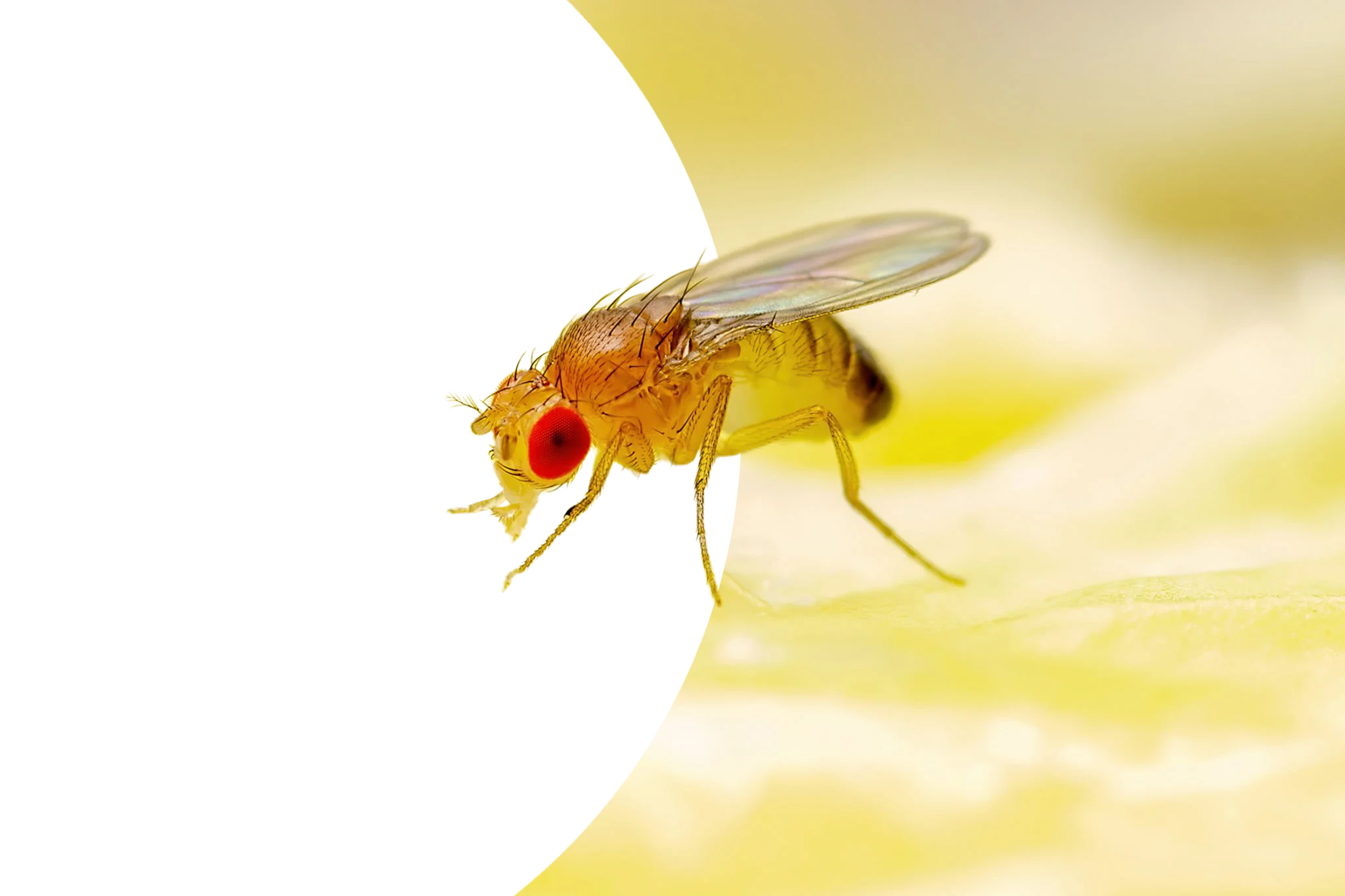Drosophila Mazes
Overview
Drosophila, a widely-used animal model in research, shares similarities with the Zebrafish model. Known for its conserved genetic pathways with humans, Drosophila is extensively employed in genetic screenings. Unlike traditional animal models like rats and mice, Drosophila offers unique advantages such as rapid development and ease of maintenance in laboratory settings. Its popularity stems from these traits, making it a favored choice for genetic studies and behavioral research.

Drosophila Food - Anesthesia - Accesories
Drosophila ConductVision: Precision Tracking for Small-Scale Behavior Studies
ConductVision offers cutting-edge tracking technology tailored for Drosophila (fruit fly) research. It allows scientists to analyze movement patterns, social behaviors, and responses to stimuli with unparalleled accuracy.
Key Features for Drosophila Research:

Micro-Scale Tracking

Temperature & Light Sensitivity Analysis

Social Interaction Mapping

Automated Locomotion Analysis

Drosophila Behaviors and Characteristics
Scientific Classification
Kingdom: | Animalia |
Phylum: | Arthropoda |
Class: | Insecta |
Order: | Diptera |
Family: | Drosophilidae |
Genus: | Drosophila |
Species: | Drosophila melanogaster |
Other behaviors & charasteristics
Drosophila melanogaster, commonly known as the fruit fly, exhibits a variety of behaviors and characteristics that make it a valuable model organism in scientific research. Here are some key behaviors and characteristics of Drosophila melanogaster:
Small Size: Adult fruit flies are typically about 2-3 millimeters in length, making them easy to handle and study in large numbers.
Short Lifespan: Under optimal laboratory conditions, the lifespan of Drosophila melanogaster ranges from about 40 to 60 days. This short lifespan allows researchers to study multiple generations relatively quickly.
Rapid Reproduction: Fruit flies reproduce quickly, with females capable of laying hundreds of eggs within their lifetime. This rapid reproduction rate facilitates genetic studies and allows researchers to observe genetic changes over successive generations.
Simple Genetics: Drosophila melanogaster has a well-characterized genome, and many genetic tools are available for manipulating and studying genes. This simplicity in genetics has made fruit flies a cornerstone of genetic research.
Courtship Behavior: Male fruit flies exhibit intricate courtship rituals involving wing vibrations, circling, and specific pheromone signals to attract females. This behavior has been extensively studied as a model for understanding sexual behavior and neurobiology.
Feeding Habits: Fruit flies primarily feed on decaying fruit and other organic materials, which is how they earned their common name. In the laboratory, they are commonly fed on a mixture of yeast, sugar, and agar.
Response to Environmental Stimuli: Fruit flies respond to a variety of environmental stimuli such as light, temperature, humidity, and food availability. Their responses to these stimuli can be studied to understand basic sensory and behavioral mechanisms.
Mutant Strains: A wide range of mutant strains of Drosophila melanogaster exist, each with specific genetic mutations affecting traits such as eye color, wing shape, behavior, and development. These mutant strains are valuable for studying gene function and genetic pathways.
Neurobiological Studies: The relatively simple nervous system of fruit flies makes them ideal for studying fundamental aspects of neurobiology, including learning, memory, and circadian rhythms.
Developmental Biology: The embryonic and larval stages of Drosophila melanogaster are well-characterized, making them a valuable model for studying developmental processes such as pattern formation and organogenesis.
History
Drosophila, initially observed by Johann Wilhelm Meigen in the 1790s, are native to tropical regions worldwide and thrive in diverse habitats. They gained prominence in the early 20th century when scientists began utilizing them for genetic studies and experimental research. Notably, Thomas Hunt Morgan’s pioneering work at Columbia University in the 1910s demonstrated Drosophila’s utility in understanding genetics (Morgan, 1910). Throughout the mid-20th century, Drosophila became increasingly prevalent in various research fields (Beadle & Ephrussi, 1935; Bridges, 1936; Lewis, 1947), but it was not until the 1970s that their role in genetics truly soared.
The pivotal figure in promoting Drosophila as a premier genetic model was American biologist Seymour Benzer. Benzer’s groundbreaking experiments on Drosophila genetics laid the groundwork for understanding the molecular basis of behavior and neurobiology (Benzer, 1967; Benzer & Waddell, 1976). His work, alongside that of others like Ed Lewis and Christiane Nüsslein-Volhard, established Drosophila as an indispensable model organism in developmental biology and neuroscience (Lewis, 1978; Nüsslein-Volhard & Wieschaus, 1980).
The genetic screens conducted by Nüsslein-Volhard and Eric Wieschaus in the late 1970s and early 1980s, known as the “Big Screens,” revolutionized Drosophila genetics. These screens utilized chemical mutagens to induce mutations, leading to the identification of key developmental pathways conserved across species, including humans (Wieschaus & Nüsslein-Volhard, 1986). Their efforts culminated in the comprehensive mapping of the Drosophila genome in 2000 (Adams et al., 2000), marking a milestone in genetic research.
Today, Drosophila continues to be a cornerstone in biological research, offering unparalleled insights into genetics, development, and behavior. Its ease of breeding, rapid lifecycle, and well-characterized genome make it an ideal model for exploring fundamental biological processes and human diseases.
Drosophila Behavioral Testing Equipmentfor Sale
At ConductVision, we offer a range of behavioral testing solutions tailored for Drosophila research laboratories

Olfatory Apparatus
Analyze Drosophila's response to odor stimuli to study olfactory learning, memory, and sensory perception.
Training Considerations and Best Practices
Standardized Handling and Housing
- Maintain consistent environmental conditions (temperature, humidity, light-dark cycle).
- Use standardized food and media compositions to ensure reproducibility.
Genetic Background and Strain Maintenance
- Maintain genetic integrity and avoid genetic drift by periodic backcrossing.
- Document and track genetic backgrounds of experimental and control strains.
Experimental Design
- Randomize sample allocation to minimize bias.
- Include appropriate controls (wild-type, mutant, and/or genetic backgrounds).
- Consider sample size calculations to ensure statistical power.
Anesthesia and Handling
- Use mild anesthetics (such as CO2 or isoflurane) for handling and experimental procedures.
- Minimize stress during handling and experiments to avoid confounding effects.
Behavioral Assays
- Standardize protocols for behavioral assays (e.g., locomotor activity, learning and memory, circadian rhythms).
- Validate assays using appropriate controls and established methods.
Data Collection and Analysis
- Record data consistently using digital tools or standardized forms.
- Employ appropriate statistical methods (e.g., ANOVA, t-tests) for data analysis.
- Consider automation and image analysis tools for high-throughput studies.
Ethical Considerations
- Follow institutional guidelines and ethical protocols for animal research.
- Minimize discomfort and distress during experiments.
- Properly dispose of biological materials and adhere to biosecurity measures.
Documentation and Reporting
- Maintain detailed records of experimental procedures, results, and observations.
- Ensure transparency in reporting methodologies and results.
- Share data and methodologies in accordance with open science principles.
Training and Skill Development
- Provide comprehensive training for researchers involved in handling and experiments.
- Encourage continuous education and skill development in Drosophila research techniques.
- Foster collaboration and knowledge exchange within the scientific community.
Standardized Handling and Housing:
- Maintain consistent environmental conditions (temperature, humidity, light-dark cycle).
- Use standardized food and media compositions to ensure reproducibility.
Genetic Background and Strain Maintenance:
- Maintain genetic integrity and avoid genetic drift by periodic backcrossing.
- Document and track genetic backgrounds of experimental and control strains.
Experimental Design:
- Randomize sample allocation to minimize bias.
- Include appropriate controls (wild-type, mutant, and/or genetic backgrounds).
- Consider sample size calculations to ensure statistical power.
Anesthesia and Handling:
- Use mild anesthetics (such as CO2 or isoflurane) for handling and experimental procedures.
- Minimize stress during handling and experiments to avoid confounding effects.
Behavioral Assays:
- Standardize protocols for behavioral assays (e.g., locomotor activity, learning and memory, circadian rhythms).
- Validate assays using appropriate controls and established methods.
Data Collection and Analysis:
- Record data consistently using digital tools or standardized forms.
- Employ appropriate statistical methods (e.g., ANOVA, t-tests) for data analysis.
- Consider automation and image analysis tools for high-throughput studies.
Ethical Considerations:
- Follow institutional guidelines and ethical protocols for animal research.
- Minimize discomfort and distress during experiments.
- Properly dispose of biological materials and adhere to biosecurity measures.
Documentation and Reporting:
- Maintain detailed records of experimental procedures, results, and observations.
- Ensure transparency in reporting methodologies and results.
- Share data and methodologies in accordance with open science principles.
Training and Skill Development:
- Provide comprehensive training for researchers involved in handling and experiments.
- Encourage continuous education and skill development in Drosophila research techniques.
- Foster collaboration and knowledge exchange within the scientific community.
Drosophila in Research
- Drosophila has a well-characterized and sequenced genome, facilitating precise genetic manipulations and studies of gene function.
- Its short generation time (about 10 days from egg to adult) allows for rapid experimental turnover and genetic crosses.
- Many fundamental biological processes discovered in Drosophila, such as embryonic development, cell signaling pathways, and circadian rhythms, are highly conserved across species, including humans.
- This conservation allows insights gained from Drosophila studies to often translate directly to understanding human biology and disease.
- Drosophila can be easily bred in large numbers and housed inexpensively.
- Its amenability to various experimental techniques, including genetic screens, behavioral assays, and neurobiological studies, makes it a versatile model for addressing diverse scientific questions.
- The fruit fly’s relatively simple nervous system, yet sophisticated behaviors, make it ideal for studying complex behaviors such as learning, memory, and response to environmental stimuli.
- Researchers can manipulate specific neural circuits and observe resulting changes in behavior, providing valuable insights into neurobiology and behavior.
- Drosophila models have been instrumental in drug discovery and screening for therapeutic compounds.
- They are also used to model human genetic diseases, allowing researchers to investigate disease mechanisms and test potential treatments in a genetically tractable organism.
- Drosophila serves as an excellent educational tool in genetics and developmental biology due to its rapid life cycle, visible phenotypes, and ease of manipulation.
- It has been instrumental in training generations of scientists in experimental techniques and research methodologies.
Strengths and Limitations
Genetic Tractability: Drosophila has a well-characterized genome with approximately 13,600 genes. This allows for precise genetic manipulations and the study of gene function, facilitating discoveries in developmental biology, behavior, and disease mechanisms.
Short Generation Time: With a rapid life cycle of about 10 days from egg to adult, Drosophila enables quick turnover in experiments. This accelerates research progress, especially in genetic studies and large-scale screens.
High Reproductive Capacity: Drosophila females lay hundreds of eggs, ensuring a large number of offspring per generation. This abundance supports statistical robustness and enhances the efficiency of genetic studies and phenotype analyses.
Conservation of Biological Processes: Many fundamental biological processes discovered in Drosophila are highly conserved across species, including humans. Insights gained from Drosophila research often translate directly to understanding human genetics and disease mechanisms.
Experimental Versatility: Drosophila supports a wide range of experimental techniques, from genetic manipulations and behavioral assays to neurobiological studies. This versatility allows researchers to address diverse scientific questions within a single model organism.
Complexity Limitations: While Drosophila provides insights into fundamental biological processes, its cellular and anatomical complexity may not always mirror human biology accurately. This can limit direct translation of findings to human disease models.
Ethical Considerations: Although less ethically contentious compared to vertebrate models, Drosophila research still involves ethical considerations, particularly regarding the use of living organisms in research and genetic manipulation.
Environmental Sensitivity: Drosophila’s development and physiology can be influenced by environmental factors such as temperature, humidity, and food quality. Maintaining consistent experimental conditions is crucial but can pose challenges in large-scale studies.
Limited Behavioral Complexity: Despite exhibiting complex behaviors, Drosophila lacks the cognitive and behavioral intricacies seen in vertebrates. This restricts its application in studying higher cognitive functions and social behaviors.
Genetic Redundancy: Some genes in Drosophila may have redundant functions, which can complicate the interpretation of genetic studies and necessitate additional validation strategies.
